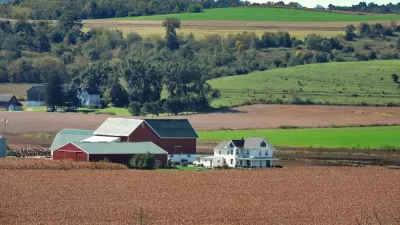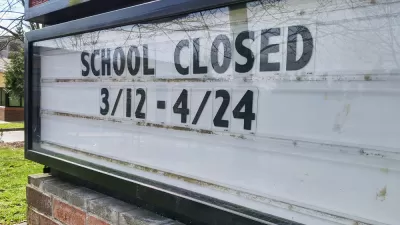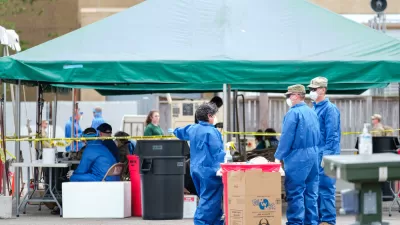Four parishes and one town in Louisiana, which has the nation's highest COVID-19 per capita death rate, are implementing strict containment strategies that go well beyond the statewide stay at home order to reduce community spread.

As of April 2, Louisiana had just over 9,000 recorded cases of COVID-19, fifth highest in the nation after N.Y., N.J., Michigan and California, according to the COVID Tracking Project via POLITICO. With 310 deaths, it was fourth after N.Y., N.J. and Michigan.
As posted earlier, St. John the Baptist Parish, La., about 30 miles west of New Orleans, led the nation with 27.8 deaths per 100,000 residents, followed by Orleans Parish—the city of New Orleans—with 25.8, according to data presented by Louisiana Gov. John Bel Edwards (D) at a news briefing Wednesday afternoon.
Faimon Roberts reports on April 2 for The New Orleans Advocate (source article) on the four parish curfews imposed by St. John the Baptist, Plaquemines, St. James, and Washington parishes. The town of Grand Isle, a barrier island in Jefferson Parish of about 1,300 people, has added travel restrictions on top of their curfew.
Grand Isle's new restrictions will require those entering the community at the southern-most point of Jefferson Parish to show proof that they own a residence or a camp there or that they are needed for their job, town officials said in a news release.
The point of the curfews and travel restrictions is to reduce outdoor social gatherings, a source of community spread, and reduce the strain on rural health care when infected residents seek treatment.
“The safety of our residents is a top priority and our medical services are limited, which is why we are putting these extra measures in place," said Grand Isle Mayor David Camardelle.
"We shut the beach down, but (some people) won’t take no for an answer," said Camardelle, adding that the average age of residents is between 50 and 90. "We are going to make sure we protect our people."
Curfew not just for pedestrians
The curfews began Wednesday night, April 1, with times varying for the municipalities. In St. James Parish, "[I]t will remain in effect each day, from 9 p.m. to 5 a.m., until further notice," according to WBRZ.
All pedestrian and vehicular movement will be prohibited during these hours except for travel associated with fire, police, emergency, hospital services, and the operation of essential businesses as provided by Governor Edwards' proclamation.
The proclamation was set to expire on April 12. On Thursday, the governor announced he had extended the order to April 30.
"It is absolutely critical that each Louisianan take this Stay at Home order seriously," said Edwards.
"Act as if your life depends on it – because it does. We have seen federal modeling data that shows that Louisiana could see more than 1,800 deaths by August. It doesn’t have to be that way. By working together, we can help flatten the curve in Louisiana, but we need all of our people to comply with the order."
Edwards was referencing the modeling prepared by the Institute for Health Metrics and Evaluation (IHME) which the White House Coronavirus Task Force unveiled on March 31. According to the Louisiana projection, the "projected peak in daily deaths" will be in 8 days, or April 9. Individual state models can be viewed by placing one's browser on "United States of America" on the homepage, https://covid19.healthdata.org/.
Testing reveals hot spots
During the White House Coronavirus Task Force press briefing on Thursday, Dr. Deborah Birx revealed that New York and New Jersey coronavirus testing showed 35 percent positives, with Louisiana the third highest at 27 percent, a measurement of hotspots.
In a separate article about Jefferson Parish leaders urging residents to practice social distancing, he reports that "an additional refrigerated unit has been brought to store bodies at the Coroner's Office" and that of the 80 deputies that were tested for the coronavirus, half were positive. Five deputies are hospitalized.
Related in Planetizen:
- Counties in Louisiana, Georgia Lead Nation in COVID Death Rate, April 3, 2020
- Straight Talk from White House Public Health Experts on What to Expect, April 2, 2020
- Predicting Hospital Capacity as the Coronavirus Spreads, March 27, 2020
- Delaware, Louisiana, and Ohio Prepare to Shut Down Non-Essential Businesses, March 24, 2020
- Hoboken First U.S. City to Shut Down Restaurants and Bars and Issue Curfew, March 16, 2020
FULL STORY: In effort to slow coronavirus, Grand Isle, Plaquemines Parish latest to announce new restrictions

Maui's Vacation Rental Debate Turns Ugly
Verbal attacks, misinformation campaigns and fistfights plague a high-stakes debate to convert thousands of vacation rentals into long-term housing.

Planetizen Federal Action Tracker
A weekly monitor of how Trump’s orders and actions are impacting planners and planning in America.

In Urban Planning, AI Prompting Could be the New Design Thinking
Creativity has long been key to great urban design. What if we see AI as our new creative partner?

Chicago’s Ghost Rails
Just beneath the surface of the modern city lie the remnants of its expansive early 20th-century streetcar system.

Baker Creek Pavilion: Blending Nature and Architecture in Knoxville
Knoxville’s urban wilderness planning initiative unveils the "Baker Creek Pavilion" to increase the city's access to green spaces.

Pedestrian Deaths Drop, Remain Twice as High as in 2009
Fatalities declined by 4 percent in 2024, but the U.S. is still nowhere close to ‘Vision Zero.’
Urban Design for Planners 1: Software Tools
This six-course series explores essential urban design concepts using open source software and equips planners with the tools they need to participate fully in the urban design process.
Planning for Universal Design
Learn the tools for implementing Universal Design in planning regulations.
planning NEXT
Appalachian Highlands Housing Partners
Mpact (founded as Rail~Volution)
City of Camden Redevelopment Agency
City of Astoria
City of Portland
City of Laramie





























